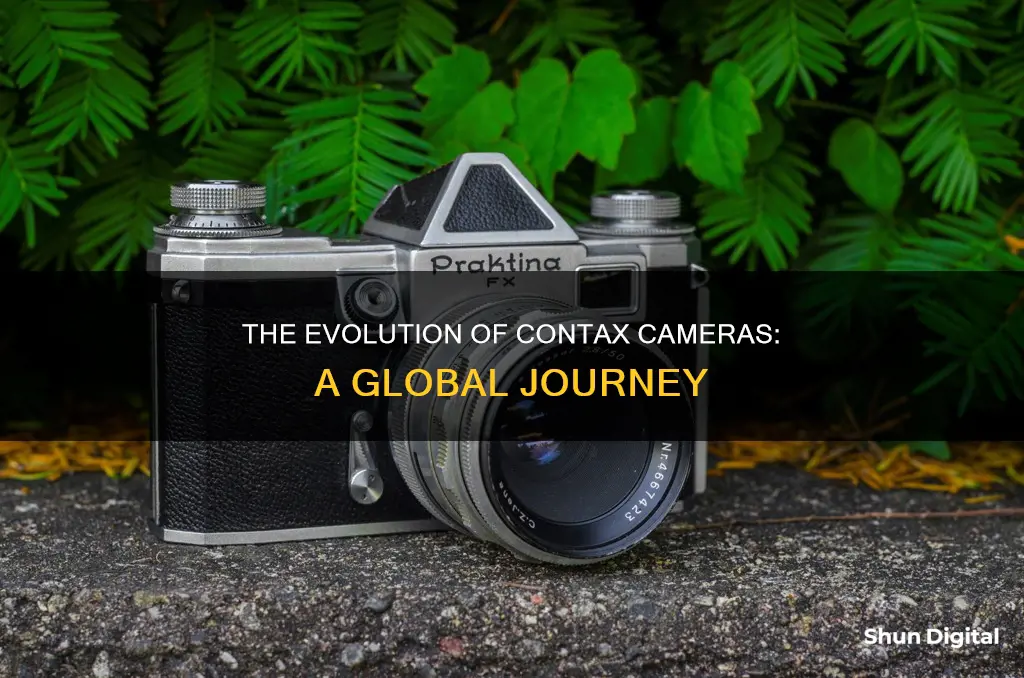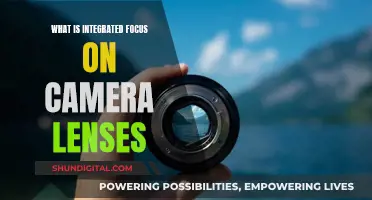
The Contax camera brand was born out of a collaboration between German optics company Carl Zeiss and Japanese camera manufacturer Yashica. The first Contax camera, the Contax RTS, was launched in the 1970s and was designed by Porsche, featuring lenses made by Zeiss. Yashica was acquired by Kyocera in 1984, and the Contax brand was discontinued in 2005.
| Characteristics | Values |
|---|---|
| Brand | Contax |
| Manufacturer | Zeiss Ikon (1932), VEB Zeiss Ikon (1949), Yashica (1972), Kyocera (1984) |
| Type | Rangefinder, SLR, DSLR |
| Film Format | 35mm, Medium Format |
| Mount | Contax/Yashica |
| Lenses | Zeiss, Yashica |
What You'll Learn

Contax cameras were made by a collaboration between Zeiss, Yashica and Porsche
Contax cameras were the result of a collaboration between Zeiss, Yashica and Porsche. The first Contax camera was released in 1932 by Zeiss Ikon and was a 35mm rangefinder camera. In 1973, Zeiss licensed the Contax name to Yashica, a Japanese camera manufacturer, to create a new line of professional 35mm SLRs. This collaboration, known as "Top Secret Project 130", aimed to combine Yashica's expertise in electronics and camera manufacturing with Zeiss's optical prowess. The F. Alexander Porsche Group was hired to design the new camera, resulting in the Contax RTS, which was released in 1974 to great acclaim.
The Contax RTS and subsequent models featured advanced electronics and renowned Carl Zeiss T* lenses, which were known for their superb optical quality. Yashica continued to produce Contax cameras until it was acquired by Kyocera in 1983. Kyocera then took over production of Contax and Yashica-branded cameras, eventually introducing its own camera models as well. Despite this change, Zeiss continued to design and manufacture lenses for the Contax cameras.
The collaboration between Zeiss, Yashica, and Porsche resulted in a range of innovative Contax cameras, including autofocus rangefinders, compacts, medium-format reflex cameras, and digital cameras. The Contax name became synonymous with high-quality optics and advanced electronics, with the cameras and lenses being sought-after by photographers and collectors alike. However, in 2005, Kyocera ceased production of all Contax-branded cameras, bringing an end to this chapter in camera history.
Activating Camera Mode in Blender Without Using Zero
You may want to see also

Zeiss licensed the Contax name to Yashica
The new Contax RTS and its Zeiss T* lenses appeared at Photokina in 1974 and proved an immediate hit. Until 1984, Contax cameras were made by Yashica in Japan, with lenses made by Carl Zeiss – some in Germany, some in Japan. The cameras were noteworthy for their advanced electronics. The Carl Zeiss T* lenses, in particular, soon gained a reputation for superb optical quality.
Contax cameras continued to be produced by Yashica until the latter was acquired by Kyocera in 1983. At that time, Kyocera's new camera division took over responsibility for production of all Contax and Yashica-branded cameras, eventually introducing cameras under its own name, as well as contracting production of other models to outside manufacturers, such as Cosina.
Charging the XP Waterproof Camera: A Step-by-Step Guide
You may want to see also

Kyocera acquired Yashica in 1984
In 1973, the Japanese manufacturer Yashica licensed the Contax name from Carl Zeiss to create a new line of 35mm cameras and interchangeable lenses in collaboration with the German company. This marked the beginning of 'Top Secret Project 130', which aimed to produce a new, professional 35mm SLR camera with an electronically-controlled shutter under the Contax brand.
Yashica was a production giant with significant expertise in electronic cameras, and it was looking for ways to boost sales and enhance brand recognition in the highly competitive 35mm SLR market. The F. Alexander Porsche Group was hired to complete an ergonomic and styling study of the new camera. The new Contax RTS, along with its Zeiss T* lenses, debuted at Photokina in 1974 and was an instant success.
Until 1984, Contax cameras were manufactured by Yashica in Japan, with lenses made by Carl Zeiss—some in Germany and others in Japan. The cameras were distinguished by their cutting-edge electronics, and the Carl Zeiss T* lenses quickly earned a reputation for exceptional optical quality.
Contax cameras continued to be produced by Yashica until the latter was acquired by Kyocera in 1983. Kyocera's new camera division then assumed responsibility for the production of all Contax and Yashica-branded cameras, eventually introducing cameras under its own name and outsourcing the production of other models to external manufacturers such as Cosina.
In 2005, Kyocera ceased production on all Contax-branded film and digital cameras.
Finding Camera Raw: Explorer Secrets Revealed
You may want to see also

Kyocera ended camera production in 2005
Kyocera, originally a ceramics manufacturer, was founded in 1959 as Kyoto Ceramic Co. Ltd. In 1983, Kyocera acquired Yashica and entered the camera market. Over the years, Kyocera produced cameras under the Yashica, Contax, and Kyocera brands.
In 2005, Kyocera announced it would be ceasing production of all cameras, including the Contax 645 system. The company's decision to exit the camera market was purely market-related and not due to financial difficulties. Instead, Kyocera chose to focus on its mobile phone and semiconductor businesses.
Kyocera's last series of 35mm Yashica SLRs, the 107/108/109MP line, was not a commercial success. The company also struggled to compete with the success of Minolta's Maxxum/Dynax 7000 autofocus camera, which was released in 1985. Kyocera's attempts to develop an autofocus 35mm SLR camera and a new series of AF lenses proved challenging, as they were introduced rather late and faced strong competition.
Despite these setbacks, Kyocera did find success in the digital camera market with models bearing Yashica, Kyocera, and Contax branding. However, their first foray into the digital SLR market, the Contax N Digital, was considered an expensive failure.
In summary, Kyocera's exit from the camera market in 2005 was driven by a shift in focus towards more profitable industries, such as mobile phones and semiconductors. The company faced challenges in keeping up with the rapidly evolving camera market and strong competition from other manufacturers.
Acti Cameras: Where Are They Manufactured?
You may want to see also

Contax cameras were made in Japan
In 1973, the Japanese company Yashica began producing cameras under the "Contax" name, licensed to it by Carl Zeiss. In 1984, Yashica was acquired in full by Kyocera, which eventually spun down camera production in 2005. The Yashica name has since been sold to a Hong Kong-based branding company, but the contemporary products that bear the name have no relation to the stalwart brand that used to be.
The Contax RTS was the result of a rare combination of talents, with Porsche design skills, Yashica electronics technology, and Carl Zeiss precision optics. The Contax Real Time System (RTS) was conceived as a purist's camera, and was fully mechanical, with an uncoupled meter. The Contax G system, which includes the G1 and G2, is the world's most advanced 35mm rangefinder camera system. The G1 was the first G system body and shot at up to 2 FPS. The G2 is a significant step up from the G1 because it adds a second active AF system to the original passive system. The G2 can also use the newest 21mm f/2.8 and 35mm f/2 lenses, while the G1 needs to be modified to take these.
The Contax 645 medium format system was a favourite of many fashion, portrait, wedding, nature and event photographers who required medium format quality, and who wanted Zeiss lenses on an autofocus 645 format body. Its competitors were the Mamiya 645, Pentax 645, and eventually the Hasselblad H1.
Recharging Camera Batteries: Efficient Nightly Routine
You may want to see also







